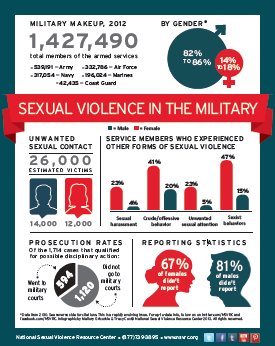There have been many reports on the extent of sexual violence within military settings (see Evaluation and Oversight). The problem is extensive and the impact is unavoidable. In 2004, a task force report on care for victims of sexual assault within the Department of Defense made recommendations for systematic changes to improve response to people who experience sexual violence (DoD Care for Victims of Sexual Assault Task Force Report, 2004).
Those recommendations included developing a central point of accountability and a unified response system. Additionally, the legal requirement to participate in the military justice system was found to be a major deterrent for service members to report crimes of sexual violence. To report a crime meant that a service member’s commander would be notified, initiating a formal investigation. Since that report, the DoD has made many changes and federal legislation has passed to help ensure proper care for victims. Recommendations from this task force led to new policy and the establishment of the Sexual Assault Prevention and Response Office (SAPRO) in the Pentagon, which provides oversight on all sexual assault prevention and response activities (Whitley, 2009). The Department of Veterans Affairs (VA) also incorporated major system changes to help provide treatment and benefits for those veterans who seek assistance with a history of military sexual trauma.
Military life and the experience of sexual violence pose unique challenges. Men and women who experience sexual assault or harassment often live and work with the person who committed this violence. If the perpetrator supervises or outranks the victim, they may make threats against the person’s career or shut out options for help and support. Service members do not have the option of leaving a job because of a hostile working environment, and could face charges for not following orders. Unit cohesion can make breaking that bond through reporting violence difficult, painful, and even threatening for a victim (Cater & Leach, 2011; Suris and Lind, 2008).
Some suggest that the culture of the military must change to prevent sexual assaults in the first place (Callahan, 2009). Natelson (2009) reports that sexual harassment is a common occurrence; additionally, unit cohesion can lead to pressures against reporting acts of violence (Natelson, 2009; Suris & Lind 2008). While many changes have been made, some contend that the DoD has not done enough to prevent and respond to sexual violence (Bhagwati, 2010). The sections below provide information on the extent of sexual violence within both the armed forces and military service academies. Additionally, there is a section on the experience, symptoms, and treatment for what the DoD has termed Military Sexual Trauma (MST).










